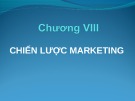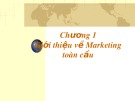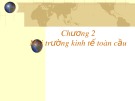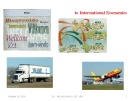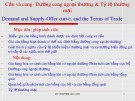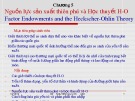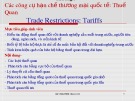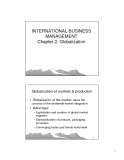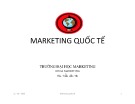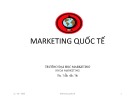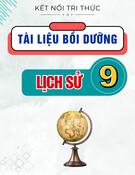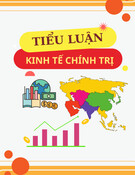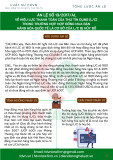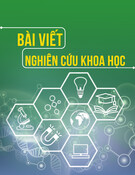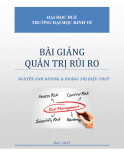to International Economics
October 18, 2016
GV NGUYEN HUU LOC UEH
1
Tài liệu bắt buộc
October 18, 2016
GV NGUYEN HUU LOC UEH
2
Ch
ổ
nươ g 1 T ng quan
Introduction
ứ ng pháp nghiên c u môn h c
ố ế ạ ủ ế ể ọ ươ ng m i qu c t ngày nay
ủ
ướ ầ ệ ố ế ủ ế qu c t
ộ
ủ ố ế ế ới th gi và living standard c a qu c gia
ụ ố ế ố động và v n qu c t
ế ế
October 18, 2016
GV NGUYEN HUU LOC UEH
3
ố ế M c ụ đích giúp sinh viên Bi ươ ủ ề t ch đ và ph Hi u rõ các xu h ể ng phát tri n chính c a th Vai trò c a toàn c u hóa kinh t ế Các thách th c hi n nay c a kinh t ứ N i dung Toàn c u hóa kinh t ầ Th ố ế ạ nươ g m i qu c t Dòng di chuy n hàng hóa, d ch v , lao ể ị Lý thuy t và chính sách kinh t ố ế qu c t Các v n ấ đề và thách th cứ c a kinh t ế ủ qu c t
What is Globalisation?
• The shift towards a more integrated and
interdependent world economy.
• Economic globalisation involves a shift
toward a system based on a consolidated global market place for production & consumption rather than on autonomous national economies (Lubbers, 2000)
October 18, 2016
GV NGUYEN HUU LOC UEH
4
Paul Krugmann’s definition Paul Krugmann’s definition
ầ
ề
• “Toàn c u hóa không ch là v n
ấ đ Qu c t
ạ
ả
ố ế ấ ớ ố
ạ
ỉ hóa ầ thương m i mà là loàn c u hóa s n xu t v i b n xu th :ế ả
ị
1. Gi m kh n
ả ăng t o giá tr gia t
ệ
ẩ ở
ấ
ấ
ị ế đ nh v
ạ ị kinh t
ăng VA (why?) Vì ả ăng tăng VA s n ph m th p thì vi c ậ ả ấ v y, khi kh n ơ s so sánh chi phí ơ ả ọ ự ch n l a n i s n xu t trên c ợ ộ ho t ạ đ ng, thông tin liên l c th p, các l đem i ích ế ở ư c ớ ấ ợ ạ ừ l i th i t l cung c p b i n ầ ủ ủ đ u c a các công ty toàn ch nhà là quan tâm hàng c uầ
October 18, 2016
GV NGUYEN HUU LOC UEH
5
Paul Krugmann’s definition Paul Krugmann’s definition
ớ
ấ
ờ
ổ
ữ ụ
ấ ộ
ủ ả
ậ
ẩ
ể ả đ m xu t kh u.
ệ
ộ
ẩ đ b o i trong
ạ ớ
ấ
ẩ
ấ công nghi p n i ngành. ậ ư c cùng lúc nh p kh u và xu t
ệ
ẩ
2. Các nư c có chi phí nhân công th p tham gia ngày càng ơn, vào quá trình trao đ i qu c t ơn, nhi u hề ố ế thư ng xuyên h . ữ ớ ư c và nh ng vùng trung tâm, không th t ể ự ả s n 3. Có nh ng n ụ ỏ ụ ầ xu t ph c v th a mãn nhu c u tiêu dùng c a mình, mà ph ạ ương m i và nh p kh u thu c vào th ụ ộ ệ ự ấ ph thu c qua l 4. Xu t hi n s ấ ả ư t ầ t c các n Nghĩa là g n nh ộ ủ kh u hàng hóa c a m t ngành công nghi p
October 18, 2016
GV NGUYEN HUU LOC UEH
6
ố ế ố ế
ầ ầ
Toàn c u hoá v.s Qu c t Toàn c u hoá v.s Qu c t
hoá hoá
ố ế
ầ
ớ ế ố
ộ
hóa c ng v i y u t
vùng mà
• Toàn c u hóa là Qu c t ệ doanh nghi p không th
ể đánh giá th p. ấ
ế
• Global factories không nh t thi
ấ ể ả
ữ i nh ng ẩ ấ đ nh: có th s n xu t ra nh ng s n ph m phù
ị ề
đ a ị đi m nh t ể h p, ợ đáp ng ứ đi u ki n c a b t c qu
ấ ạ ả ả t ph i s n xu t t ả ữ ấ ệ ủ ấ ứ ốc gia nào.
• Global factory NOT limited to manufacturing • Eg. Software development and distribution for global banking firms
October 18, 2016
GV NGUYEN HUU LOC UEH
7
Dimensions of Globalisation
Markets Production Capital
October 18, 2016
GV NGUYEN HUU LOC UEH
8
Economic Dimention International Integration International Integration
Trade/investment organisations (multilateralism)
Multinational corporations (latecomers)
• Rules of the game
Trade & investment (acquisition, marketing, finance)
• Players
Countries (Triad + BRICs + Developing countries)
• The game
Check this out: Friedman, Thomas L. (1999) The Lexus and the Olive Tree: Understanding Globalization, Farrer, Straus & Giroux.
October 18, 2016
GV NGUYEN HUU LOC UEH
9
• The playing field
Globalisation of Markets
Exploitation and creation of global market segments, ie. ipod, Coca cola, industrial goods (chemicals)
Google Earth & iphone http://jp.youtube.com/watch?v=v6BPuKaLel4
Standardisation of products, packaging, promotion
Converging tastes and trends worldwide
Alternative view: Naomi Klein No Logo: Brands, Globalization & Resistance http://jp.youtube.com/watch?v=uI0itS3gQFU
GV NGUYEN HUU LOC UEH
October 18, 2016
10
Globalisation of Capital
International institutions (gold standard)
• • Floating currencies •
Instantaneous international capital transaction and transfer
• Rise (and fall) of global financial institutions
Contagion effect (eg. Asian financial crisis, US subprime mortgage
market)
International portfolio investment
Video: The End Of Globalisation – World – Globalisation at a crossroads http://jp.youtube.com/watch?v=2EVWE5XNeDc
October 18, 2016
GV NGUYEN HUU LOC UEH
11
Novel Features of Globalisation today
• Follows a prolonged period of inward orientation
•
(protectionism) International players include governments (whose role is declining) as well as MNEs, multilateral agencies, NGOs
• Dramatic increase in flows of trade, investment, people • Growing importance of international production (deep
integration) over trade and capital movements (shallow integration) Information and knowledge driven
• • Extended international division of labour
October 18, 2016
GV NGUYEN HUU LOC UEH
12
Implications of A Global World
• Economic activities formerly under national control now under MNE control eg.capital, privatised assets
• National economies (ie. countries) linked through
markets (trade) and through international production (FDI)
• Economic (business) linkages reinforced by cross border flow of norms, values, business culture
• Marketbased economic systems
October 18, 2016
GV NGUYEN HUU LOC UEH
13
Drivers of Globalisation
1. MNES 2. Transportation technology 3. Communications technology 4. Political ideologypeace 5. Liberalisation of trade/investment 6. Movement of people
October 18, 2016
GV NGUYEN HUU LOC UEH
14
1. MNEs
• •
• •
1970 700 MNEs, 1998 60,000 (with 500,000 foreign affiliates) 1997 FDI reached its peak, MNEs accounted for 25% of world GDP, 33% of world exports 1970, US$1020b exchanged daily on currency markets 1997 FDI is growing faster than international trade – 39% increase
• Trade • Finance • FDI • M&As • Alliances
2007 FDI peaked again - rising by 30% to reach $1,833 billion 2008 FDI declined by 15% due to the global financial crisis
MNEs are so large and powerful that they have replaced nationstates as the defining power structures of the global economy of the world's 100 largest economies, 51 are corporations
October 18, 2016
GV NGUYEN HUU LOC UEH
15
Approximately 79,000 MNEs, and 790,000 affiliates 200 MNEs now control over ¼ world economic activity Forex market today = US$trillions
2. Transportation Technology 2. Transportation Technology
The Shrinking Globe Transportation
1500 1840
1850 1930
1950s
1960s
Today: Supersonic flight (Concorde) Singapore Airlines A380 – 500+ passengers, speed Mach 0.89
Propeller aircraft 300 400 mph.
Steam locomotives average 65 mph. Steamships average 36 mph.
Jet passenger aircraft, 500 700 mph.
Best average speed of horsedrawn coaches and sailing ships, 10 mph.
©The McGrawHill Companies, Inc., 2000
©The McGrawHill Companies, Inc., 2000
October 18, 2016
GV NGUYEN HUU LOC UEH
16
3. Communications Technology
199095 TV sets per thousand people doubled to 235
•
• The world is witnessing unprecedented transformation into an informationbased society.
• • This is driven by • • Mid1990s number of minutes of international telephone communications doubled to 70 billion 1998 140 million Internet users in 1998, by 2002 there were 600 million 2000 – 12% of the world owned a mobile phone
Implications for the spread of knowledge … Over half the GDP in major OECD countries is knowledgebased.
22% internet penetration (from 74% N.A to 5% Africa Mobile phone use expected to reach 50% of world’s population (3.3
October 18, 2016
GV NGUYEN HUU LOC UEH
17
major technological changes in communications and computers. 20002008 Internet users – tripled to 1,464 millon billion subscribers) in 2008
4. (Relative) Peace
End of the Cold War
• • Change towards Capitalism and Market Ideology, but also
• Dominance of US market forces and capitalism – but not always peacefully!
•
• Rise of emerging
communism socialism still dominant in parts of Asia, Latin America Bases of Power –Colonial control (1870s1945) – Imperialist power –Cold war rivalry between Soviet/US blocs (19451990) – Military power –Informal, economic competition (1990 onwards) – Economic power
markets, especially China and continued dominance of Europe, coupled with financial problems in the US may undermine this dominance
• Rise of politically and faithmotivated conflict
• Multipolar world?
October 18, 2016
GV NGUYEN HUU LOC UEH
18
Today: Terrorist acts New US president (new view?) Economic power Implications for the future?
5. Liberalisation
1980s • Macroeconomic stability – reduction of fiscal
deficits
• Reduced role for government – deregulation
and privatisation • • Greater openness to the outsidereduced • Unprecedented levels of economic cooperation between countries, especially with regard to trade International capital markets trade and investment barriers
• Multilateral and
October 18, 2016
GV NGUYEN HUU LOC UEH
19
supranational governance (G20) TODAY •Almost all new regulations and agreements serve to promote trade and investment • Regional economic integration is now firmly embedded in Europe, growing in North (and to a lesser extent, South) America, and rapidly increasing in Asia
6. Movement of People
In the 20th Century, the world’s population grew from 1.6 to 6 billion – 2 billion in the last 30 years Population growth concentrated in developing countries, and in cities
October 18, 2016
GV NGUYEN HUU LOC UEH
20
TODAY •World population = 6.7 billion, 3.2 billion live in cities, 3.4 in rural areas • Population growth has slowed to 1.3% • 190 million (3%) immigrants, 13.5 are refugees • SouthSouth and SouthNorth immigration • Travel almost 900 million tourist arrivals TOMMOROW • 2 billion added to world population in the next 30 years •Concentrated in developing countries, urban areas
Globalization of production
October 18, 2016
GV NGUYEN HUU LOC UEH
21
Another example of global sourcing (BMW)
– Automaker BMW employs 70,000 factory personnel at 23
sites in 13 countries to manufacture its vehicles.
– The Munich plant builds the BMW 3 Series and supplies
engines to other BMW factories abroad.
– The South Carolina plant makes 500 vehicles daily. – A plant in NE China makes cars in a local joint venture. – A plant in India makes BMWs for the Asian market. – BMW configures sourcing to minimise costs (by producing
in China), access skilled personnel (by producing in Germany), and remain close to key markets (by producing in China, India, and the United States).
October 18, 2016
GV NGUYEN HUU LOC UEH
ố ế
ố
Th
ạ nươ g m i qu c t
và living standard qu c gia
ộ
ố
• Sự ph thu c t ụ
nươ g h giổ ữa các qu c gia
October 18, 2016
GV NGUYEN HUU LOC UEH
23
ố ế
ố
Th
ạ nươ g m i qu c t
và living standard qu c gia
• Sự ph thuụ
ộc kinh t
nươ g h giổ ữa các
n
cướ có xu h
tế ngướ tăng
October 18, 2016
GV NGUYEN HUU LOC UEH
24
ế
Vai trò th
Hoa
ố ế đối với kinh t ạ nươ g m i qu c t Kỳ
October 18, 2016
GV NGUYEN HUU LOC UEH
25
ả
ố
Dòng ch y lao
ố động và v n qu c tế
October 18, 2016
GV NGUYEN HUU LOC UEH
26
ế
Ch ủ đề nghiên cứu c aủ ố ế môn Kinh t
Qu c t
ộ
• Liên quan đến v n ấ đề ph thu c t
ề
ế
nươ g h ổ ố
v kinh t
và tài chính gi
ụ ữa các qu c gia
ị
ụ
ộ
• Phân tích dòng hàng hóa, d ch v , thanh toán cướ v i ớ các n cướ còn gi a m t n ệ ế ới, các chính sách can thi p vào ngưở đến lợi ả
ề ệ ữ và ti n t ạ i trên th gi l ả các dòng ch y nói trên và nh h ố ích qu c gia
October 18, 2016
GV NGUYEN HUU LOC UEH
27
ế
Ch ủ đề nghiên cứu c aủ ố ế môn Kinh t
Qu c t
ạ nươ g m i qu c t
• Lý thuy t thế nươ g m i qu c t ạ ừ ợ ở cơ s và các l th i ích t • Chính sách th ạ nươ g m i qu c t
ụ ạ
ạ nươ g m i qu c t
ố ế phân tích ố ế . ả ố ế kh o sát ế lý do và tác động c a các công c h n ch ủ ố ế . th ố ế ị
th tr
nườ g ngo i h i ề ệ
ạ ố đổi ti n t
• Tài chính qu c t ứ nghiên c u các ộ ủ c a m t n
định ch v trao ế ề cướ khác ớ cướ v i các n
October 18, 2016
GV NGUYEN HUU LOC UEH
28
ế
Ch ủ đề nghiên cứu c aủ ố ế môn Kinh t
ọ ỳ ướ • Trong các h c k tr
Qu c t ượ ề ệ
ị ườ ứ ề ị ế c trang b ki n th c v các lý ạ ạ , các lo i th tr ng c nh tranh,
ủ ậ ạ ộ ộ ng h i nh p, các l i ích c a ngo i th
ự ươ ủ ộ
ươ ạ ầ ườ ọ ế do đem đ n cho ố ớ ng đ i v i nhà ế i tiêu dùng là n i dung quan tr ng c n phân tích ti p theo
ế c, sinh viên đã đ ế thuy t và các chính sách tài khóa, ti n t ề ị ườ ng đ c quy n th tr • V i xu h ướ ợ ớ ng t ướ c tham gia và tác đ ng c a chính sách ngo i th các n ộ ấ ả s n xu t, ng trong ch • Đ đ t đ ậ ử ng trình b c c nhân kinh t ầ c yêu c u này ng
ườ ọ i h c ph i dùng đ n các ph ể ế ế . ả vi mô, vĩ mô đ phân tích các chính sách ngo i th ng.
ươ ể ạ ượ phân tích kinh t ụ ạ • Thí d t i sao chính sách bán phá giá có th t ươ ng pháp ạ ươ ậ i nhu n cho
ệ ạ t h i ể ố ng l ợ ng gây ra thi
ủ ế ế ộ
ề ẩ
ệ i đa hóa l ườ ạ i th ế ướ ừ ươ ư ệ ạ ể ạ qu c gia? Làm th nào đ h n ch tác đ ng c a chính ướ ấ ng tăng v n đ áp ấ khi Vi t nam gia
October 18, 2016
GV NGUYEN HUU LOC UEH
29
doanh nghi p nh ng chính sách ngo i th ố ề cho n n kinh t ệ ấ c xu h sách này cho doanh nghi p xu t kh u tr ế ố ẩ ố ớ thu ch ng bán phá giá đ i v i hàng xu t kh u t ậ nh p WTO?
ế
ố ế ệ
Đ c trặ
ưng kinh t
qu c t
hi n nay
ươ
ầ toàn c u ngày càng liên h đ n s phát tri n c a ề i đang phát tri n
ể ủ ng Tây truy n
ệ ế ự ế ớ i ph
ể thay vì th gi
• Kinh t ế ế ớ th gi th ng.ố
ộ ạ
ỹ
• 2030 châu Á s v
ẽ ượ ắ ố
t B c M và châu Âu g p l ầ ư
ự
tiêu chí:GDP, dân s , chi tiêu quân s và đ u t
ữ i trong nh ng ệ (Reuters,TT, công ngh
Dec 12 2012)
ố ộ ươ
ố
• EU, Nh t và Nga duy trì xu h
ậ ng đ i ch m; m t
ng t c đ t
ậ
ổ
ộ ậ c h ng trung n i lên nh Colombia, Ai C p, Indonesia,
ướ ố ướ ạ ư s n ỳ Mexico, Nam Phi và Th Nhĩ K .
ổ ề Trung Qu c nhi u kh năng s v
• Kinh t
ế ẫ
ố ể
ả ị
ế v trí siêu c ố
t M tr ủ ớ
ả
ợ
ỹ ướ ẽ ượ c 2030 ườ c a M v công ỹ ề ư song v n ch a th thay th ng ủ ệ ậ ệ ngh và vi c t p h p các liên minh đ i phó v i kh ng ho ng toàn c u.ầ
October 18, 2016
GV NGUYEN HUU LOC UEH
30
Relationship between Tariffs, World GDP, and the Volume of World Trade
October 18, 2016
GV NGUYEN HUU LOC UEH
31
ế
ố ế ệ
ứ Thách th c kinh t
qu c t
hi n nay
ế ớ ẽ ưở
• Th gi
i s h
ệ công ngh tính đ n
ng l ự ế
ậ
ữ
ạ
ọ
ế ợ ớ ừ i l n t ơ ổ năm 2030 song s bi n đ i khí h u có nguy c ứ i nh ng thách th c nghiêm tr ng. mang l
ề ướ
ầ
ậ
ố
• Dân s và thu nh p gia tăng, nhu c u v n
ượ
ủ
c, ầ
ự
ầ ng c a toàn c u tăng d n
ng th c và năng l
.
ươ l ế cho đ n 2030
October 18, 2016
GV NGUYEN HUU LOC UEH
32
Global Growth
Where would you invest?
October 18, 2016
GV NGUYEN HUU LOC UEH
33
ế
ố ế ệ
ứ Thách th c kinh t
qu c t
hi n nay
ướ c t
ị ạ ề ế ổ
ệ ỉ
ộ
ụ ữ
• 26/11 – 7/12/2012 có 200 n ể i Doha đ ạ ệ gia h n Hi p đ nh Kyoto,1997 v bi n đ i ậ ẽ ế ạ khí h u s h t h n vào 12/2012, • Ch có EU, Úc và ít n ỏ ướ c nh có thi n chí ớ ứ ế ờ ạ tham gia m t th i h n cam k t th hai v i ả ớ ả nh ng m c tiêu gi m khí th i m i. ậ ả • New Zealand, Canada, Nh t B n và Nga thì
ướ ỉ ể
ả ượ
ế ộ
October 18, 2016
GV NGUYEN HUU LOC UEH
34
ạ ị không, nhóm n c kho ng 14% l đ ể ạ ẽ nên s không th t o ra đ c s thay đ i l n ố trong cu c chi n ch ng bi n đ i khí h u toàn c uầ : 7/12/2012 các n ằ b ng cách ệ c thi n chí này ch ki m soát ầ ả ượ ng khí th i toàn c u ổ ớ ượ ự ậ ổ ế ả cướ ti p t c trì ho n ế ụ đền 2020. ệ gia h n Hi p đ nh Kyoto
ế
ố ế ệ
ứ Thách th c kinh t
qu c t
hi n nay
• Trái đất s nóng thêm 4 ẽ ể ồ
độ: nhi u khu v c ự ề ầ ọ
ọ
ả không th tr ng tr t gây th m h a toàn c u. Chì nóng lên 0,8 độ v a qua đã d n ẩ đến h n ạ ừ hán, l
nươ g th c tự ăng m nh.ạ
t, giá l
ủ ụ l
ệ
ự
ạ : ở Hai tr ng i • LDCs tri n yêu c u ể
ệ
ể
ị ệ ứ
ướ
ấ
ầ DCs th c hi n các cam ế ả k t theo hi p đ nh Kyoto là gi m thi u các ạ . lo i khí có hi u ng nhà kính khác • Các n ệ ả
ợ ưở
c giàu cung c p thêm vi n tr cho ớ ng
ọ ứ ổ
LDCs giúp h ng phó v i các nh h ậ . ủ ự ế c a s bi n đ i khí h u
October 18, 2016
GV NGUYEN HUU LOC UEH
35
ế
ố ế ệ
ứ Thách th c kinh t hi n nay qu c t
•
ố ở ả ế ứ ỗ ấ ừ
ệ Ấ ướ ế ị Trung Qu c (x p th 5 t ộ i đ m lên), 574 USD (Vi
ố
ỹ
ả ướ ấ ạ
• ươ ườ ng LHQ (UNEP) : t p trung khí ng trình Môi tr
ệ ứ CO2 gây ệ ố 2000, do vi c đ t
ậ ể ừ & tăng 20% k t ệ ộ ể t đ trong vòng ki m soát đang
October 18, 2016
GV NGUYEN HUU LOC UEH
36
ộ 102010 International Energy Agency: năm 2008, giá tr GDP làm ra tính trên m i t n khí CO2 th i ra là 435 USD t Nam), 579 USD ( n Đ ), 632 USD (Nga), d 1.783 USD (Campuchia), 2.003 USD (Hàn Qu c), 2.030 USD (Úc), 2.291 ậ USD (M ), 2.459 USD (Lào), 2.476 USD (Singapore), 3.374 USD (Nh t B n), 3.712 USD (EU), 5.928 USD (Pháp),…. N c “s ch” nh t là Chad 15.924 USD. 12/2012 Ch ế ụ hi u ng nhà kính ti p t c tăng lên than đá và d uầ , m c tiêu gi ữ ụ cho nhi ế ớ ẽ ỏ ầ ượ t ra kh i t m tay và th gi v i s tăng thêm 35 đ C trong th k ế ỷ 21.
Limits to a Global World
• Loss of sovereignty – who holds the power? Nation states,
MNEs, multilaterial organisations? Inequality North/South Divide.
• • Contagion effects: Economic, financial even political events
in one country increasingly effect other countries.
• Global Problems – environmental damage, sustainability,
financial crises, terrorism, ethic conflicts, piracy, computer viruses, GE, pollution, disease (superbugs) …
Read more: Chossudovsky, M. 2009. The Globalisation of Poverty and the New World Order. Global Research.
October 18, 2016
GV NGUYEN HUU LOC UEH
37
Limits to a Global World
• Economic conditions • Cultural differences • Barriers to trade and investment
• political, cultural, economic, technological, geographical
Countries are different!
• Political uncertainty, war • Resources
S T E P
• Reduce, reuse, recycle; limits to consumerism
• Capitalist system
• not universally adopted, nor infallible
Policymaker must recognise and appreciate these differences
October 18, 2016
GV NGUYEN HUU LOC UEH
38
Limits to a Global World
October 18, 2016
GV NGUYEN HUU LOC UEH
39
Visit and discuss different economies …
E C O N O M y
October 18, 2016
GV NGUYEN HUU LOC UEH
40

